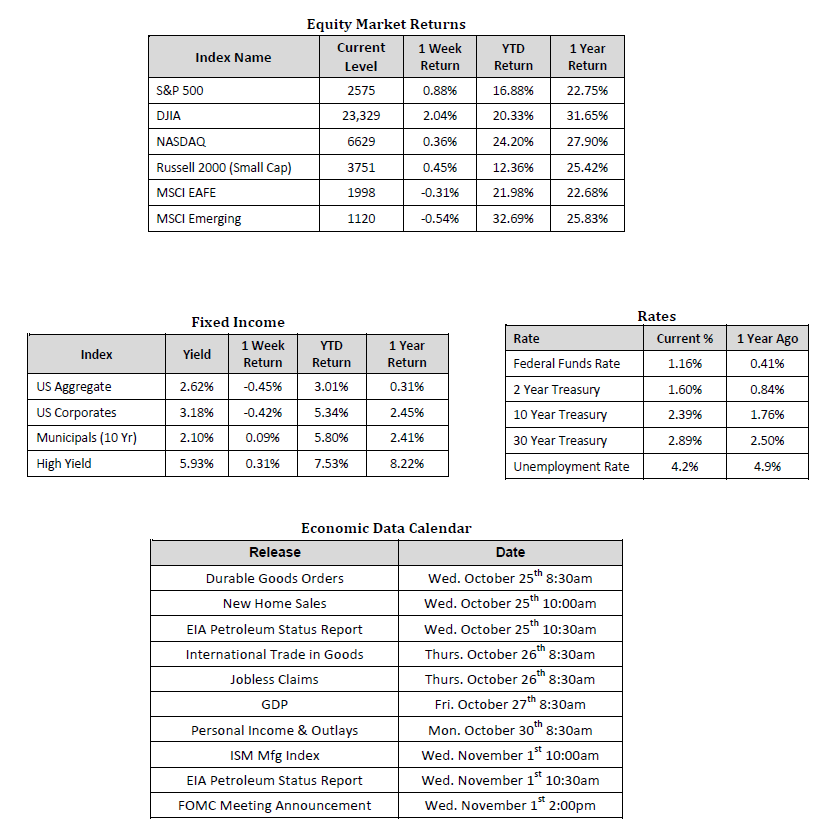
How Much Higher Can Stocks Climb?
Market Overview
Sources: Sources for data in tables: Equity Market and Fixed Income returns are from JP Morgan as of 10/20/17. Rates and Economic Calendar Data from Bloomberg as of 10/24/17. International developed markets measured by the MSCI EAFE Index, emerging markets measured by the MSCI EM Index. Sector performance is measured using GICS methodology.
Happening Now
Stocks gained for a sixth straight week with the S&P 500 Index gaining 0.9%, the Russell Midcap index gaining 0.8%, and small cap stocks, as measured by the Russell 2000 Index, moving 0.5% higher. International equities declined last week with developed markets losing 0.3% and emerging markets falling 0.5%. Consistent with the “risk-on” trade that we’ve seen since September, bond yields ticked higher across the curve last week with the 2 Year, 10 Year and 30 Year U.S. Treasury Yields rising 0.9%, 0.11%, and 0.8% respectively.
Equity markets continue to reach all-time highs this year and volatility has held steady near an all-time low. The slow economic recovery that has taken place has been fueled in part by ultra-low interest rates and central bank asset purchases. With talk of rates potentially headed higher and, simultaneously, the Federal Reserve reducing the size of their balance sheet, many have been left wondering how much longer the second oldest bull market on record can march on. Stepping back and taking scope of the stock market’s performance over the past eight years can make this question even more daunting. Consider that the S&P 500 Index rallied over 260% since bottoming in March of 2009; investors with enough reserve to stay invested during the turmoil of 2007 – 2009 have been met with eight straight calendar years of gains in U.S. Stocks. Barring a dramatic drop this quarter, 2017 appears set to be the ninth consecutive year of gains.
We’ve worked with clients to help address this concern by finding innovative strategies that could allow them to remain invested without experiencing the ups and downs a typical portfolio of individual stocks may deliver. By screening for stocks with distinct characteristics, focusing on our exposure to certain sectors, and having a fundamental understanding of a client’s asset allocation needs, we help create the potential for long term success.
Important Information and Disclaimers
Disclosures: Hennion & Walsh is the sponsor of SmartTrust® Unit Investment Trusts (UITs). For more information on SmartTrust® UITs, please visit www.smarttrustuit.com. The overview above is for informational purposes and is not an offer to sell or a solicitation of an offer to buy any SmartTrust® UITs. Investors should consider the Trust’s investment objective, risks, charges and expenses carefully before investing. The prospectus contains this and other information relevant to an investment in the Trust and investors should read the prospectus carefully before they invest.
Investing in foreign securities presents certain risks not associated with domestic investments, such as currency fluctuation, political and economic instability, and different accounting standards. This may result in greater share price volatility. These risks are heightened in emerging markets.
There are special risks associated with an investment in real estate, including credit risk, interest rate fluctuations and the impact of varied economic conditions. Distributions from REIT investments are taxed at the owner’s tax bracket.
The prices of small company and mid cap stocks are generally more volatile than large company stocks. They often involve higher risks because smaller companies may lack the management expertise, financial resources, product diversification and competitive strengths to endure adverse economic conditions.
Investing in commodities is not suitable for all investors. Exposure to the commodities markets may subject an investment to greater share price volatility than an investment in traditional equity or debt securities. Investments in commodities may be affected by changes in overall market movements, commodity index volatility, changes in interest rates or factors affecting a particular industry or commodity.
Products that invest in commodities may employ more complex strategies which may expose investors to additional risks.
Investing in fixed income securities involves certain risks such as market risk if sold prior to maturity and credit risk especially if investing in high yield bonds, which have lower ratings and are subject to greater volatility. All fixed income investments may be worth less than original cost upon redemption or maturity. Bond Prices fluctuate inversely to changes in interest rates. Therefore, a general rise in interest rates can result in the decline of the value of your investment.
Definitions
MSCI- EAFE: The Morgan Stanley Capital International Europe, Australasia and Far East Index, a free float-adjusted market capitalization index that is designed to measure developed-market equity performance, excluding the United States and Canada.
MSCI-Emerging Markets: The Morgan Stanley Capital International Emerging Market Index, is a free float-adjusted market capitalization index that is designed to measure the performance of global emerging markets of about 25 emerging economies.
Russell 3000: The Russell 3000 measures the performance of the 3000 largest US companies based on total market capitalization and represents about 98% of the investible US Equity market.
ML BOFA US Corp Mstr [Merill Lynch US Corporate Master]: The Merrill Lynch Corporate Master Market Index is a statistical composite tracking the performance of the entire US corporate bond market over time.
ML Muni Master [Merill Lynch US Corporate Master]: The Merrill Lynch Municipal Bond Master Index is a broad measure of the municipal fixed income market.
Investors cannot directly purchase any index.
LIBOR, London Interbank Offered Rate, is the rate of interest at which banks offer to lend money to one another in the wholesale money markets in London.
The Dow Jones Industrial Average is an unweighted index of 30 “blue-chip” industrial U.S. stocks.
The S&P Midcap 400 Index is a capitalization-weighted index measuring the performance of the mid-range sector of the U.S. stock market, and represents approximately 7% of the total market value of U.S. equities. Companies in the Index fall between S&P 500 Index and the S&P SmallCap 600 Index in size: between $1-4 billion.
DJ Equity REIT Index represents all publicly traded real estate investment trusts in the Dow Jones U.S. stock universe classified as Equity REITs according to the S&P Dow Jones Indices REIT Industry Classification Hierarchy. These companies are REITSs that primarily own and operate income-producing real estate.




